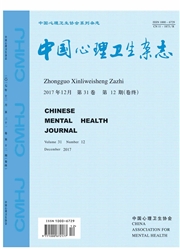

 中文摘要:
中文摘要:
目的:考察老年人抑郁症状与情绪调节策略的关系及老年人抑郁症状的相关因素,为老年人抑郁症状的干预提供理论指导.方法:选取北京市某社区60~80岁老年人335名,用流调中心用抑郁量表(CES-D,得分≥16分为“有抑郁症状”)来评估老年人抑郁症状,用Gross情绪调节问卷(ERQ,包括认知重评和表达抑制两个分量表)来评估老年人认知重评和表达抑制策略的使用情况,用沉思量表(RRS)来测量老年人沉思策略的使用情况,并用logistic回归分析方法对老年人抑郁症状的相关因素进行分析.结果:有抑郁症状的老年人的比例为19.9% (61/306).CES-D总分与ERQ的认知重评得分呈负相关(r=-0.21,P<0.01),与ERQ的表达抑制得分的相关无统计学意义(r=0.08,P>0.05),与RRS总分呈正相关(r=0.58,P<0.01).Logistic回归分析表明,男性(OR =0.42,P<0.05)、健康状况好(OR =0.29,P<0.001)、生活方式好(OR =0.09,P<0.01)、经济状况好(OR =0.05 ~0.23,P<0.01)和ERQ认知重评得分较高(OR =0.93,P<0.05)的老年人,CES-D得分较低;而高龄(OR =1.04,P<0.05)和RRS总分较高(OR=1.19,P<0.01)的老年人,CES-D得分较高.结论:女性、高龄、经济状况差、健康水平低、无子女或子女在外地或国外、越多使用沉思策略和越少使用认知重评策略的老年人,越可能出现抑郁症状.
 英文摘要:
英文摘要:
Objective: To explore the relationship between depressive symptom and emotion regulation, and the related factors of depressive symptom in Chinese aged, in order to provide insights to the psychological therapy for ol- der adults with depressive symptoms. Methods: Totally 335 adults aged 60 to 80 years from communities in Beijing were surveyed with the Center for Epidemiologic Studies Depression Scale (CES-D, with score of ≥16 as having de- pressive symptoms) for assessing depressive symptoms, with the Emotion Regulation Questionnaire (ERQ, consisting of cognitive reappraisal subscale and expressive suppression subscale) for assessing cognitive reappraisal and expres- sive suppression, and with the Ruminative Response Scale (RRS) for assessing rumination. Logistic analysis was used to explore the depressive symptom-related factors. Results: In the sample, 19. 9% of the older adults were screened out as having depressive symptoms. The CES-D scores were negatively correlated with the ERQ cognitive reappraisalsubscale scores (r = -0. 21, P 〈0. 01) and positively correlated with RRS total scores (r =0. 58, P 〈0. 01), while no correlation with the ERQ expressive suppression subscale scores (r = 0. 08, P 〉 0. 01). Logistic regression revealed that those who were males (OR =0. 42, P 〈0. 05), with better self-rated health status (OR =0.29, P 〈0. O31), with better living style (OR =0. 09, P 〈0. 01), with higher economic level (OR =0. 05 -0. 23, P 〈0. 01), and with higher cogni- tive reappraisal subscale score (OR =0. 93, P 〈0. 05) scored lower in CES-D. Those who had older age (OR = 1.04, P 〈 0. 05) and higher RRS scores (OR = 1.19, P 〈 0. 01) scored higher in CES-D. Conclusion: It suggests that those who are females, with older age, with lower economic level, in worse self-rated health state, without adult children or with adult children not living closely, more frequently using rumination, and less frequently using cognitive reappraisal ma
 同期刊论文项目
同期刊论文项目
 同项目期刊论文
同项目期刊论文
 期刊信息
期刊信息
